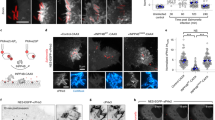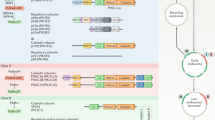Abstract
Phosphatidylinositol-4,5-bisphosphate (PtdIns-4,5-P2), a key molecule in the phosphoinositide signalling pathway, was thought to be synthesized exclusively by phosphorylation of PtdIns-4-P at the D-5 position of the inositol ring. The enzymes that produce PtdIns-4,5-P2 in vitro fall into two related subfamilies (type I and type II PtdInsP-5-OH kinases, or PIP(5)Ks) based on their enzymatic properties and sequence similarities1. Here we have reinvestigated the substrate specificities of these enzymes. As expected, the type I enzyme phosphorylates PtdIns-4-P at the D-5 position of the inositol ring. Surprisingly, the type II enzyme, which is abundant in some tissues, phosphorylates PtdIns-5-P at the D-4 position, and thus should be considered as a 4-OH kinase, or PIP(4)K. The earlier error in characterizing the activity of the type II enzyme is due to the presence of contaminating PtdIns-5-P in commercial preparations of PtdIns-4-P. Although PtdIns-5-P was previously thought not to exist in vivo, we find evidence for the presence of this lipid in mammalian fibroblasts, establishing a new pathway for PtdIns-4,5-P2 synthesis.
This is a preview of subscription content, access via your institution
Access options
Subscribe to this journal
Receive 51 print issues and online access
$199.00 per year
only $3.90 per issue
Buy this article
- Purchase on Springer Link
- Instant access to full article PDF
Prices may be subject to local taxes which are calculated during checkout



Similar content being viewed by others
References
Loijens, J. C., Boronenkov, I. V., Parker, G. J. & Anderson, R. A. The phosphatidylinositol 4-phosphate 5-kinase family. Adv. Enz. Reg. 36, 115–140 (1996).
Damen, J. E. et al. The 145-kDa protein induced to associate with Shc by multiple cytokines is an inositol tetraphosphate and phosphatidylinositol 3,4,5-triphosphate 5-phosphatase. Proc. Natl Acad. Sci. USA 93, 1689–1693 (1996).
Meyers, R. & Cantley, L. C. Cloning and characterization of a wortmannin-sensitive human phosphatidylinositol 4-kinase. J. Biol. Chem. 272, 4385–4390 (1997).
Whiteford, C. C., Brearley, C. A. & Ulug, E. T. Phosphatidylinositol 3,5-bisphosphate defines a novel PI 3-kinase pathway in resting mouse fibroblasts. Biochem. J. 323, 597–601 (1997).
Ling, L. E., Schulz, J. T. & Cantley, L. C. Characterization and purification of membrane-associated phosphatidylinositol-4-phosphate kinase from human red blood cells. J. Biol. Chem. 264, 5080–5088 (1989).
Bazenet, C. E., Ruano, A. R., Brockman, J. L. & Anderson, R. A. The human erythrocyte contains two forms of phosphatidylinositol-4-phosphate 5-kinase which are differentially active toward membranes. J. Biol. Chem. 265, 18012–18022 (1990).
Auger, K. R., Serunian, L. A., Soltoff, S. P., Libby, P. & Cantley, L. C. PDGF-dependent tyrosine phosphorylation stimulates production of novel polyphosphoinositides in intact cells. Cell 57, 167–175 (1989).
Carpender, C. L. & Cantley, L. C. Phosphoinositide kinases. Biochemistry 29, 11147–11156 (1990).
Boronenkov, I. V. & Anderson, R. A. The sequence of phosphatidylinositol-4-phosphate 5-kinase defines a novel family of lipid kinases. J. Biol. Chem. 270, 2881–2884 (1995).
Divecha, N., Truong, O., Hsuan, J. J., Hinchcliffe, K. A. & Irvine, R. F. The cloning and sequence of the C isoform of PtdIns4P 5-kinase. Biochem. J. 309, 715–719 (1995).
Hinchliffe, K. A., Irvine, R. F. & Divecha, N. Aggregation-dependent, integrin-mediated increases in cytoskeletally associated PtdInsP2(4,5) levels in human platelets are controlled by translocation of PtdIns 4-P 5-kinase C to the cytoskeleton. EMBO J. 15, 6516–6524 (1996).
Castellino, A. M., Parker, G. J., Boronenkov, I. V., Anderson, R. A. & Chao, M. V. Anovel interaction between the juxtamembrane region of the p55 tumor necrosis factor receptor and phosphatidylinositol-4-phosphate 5-kinase. J. Biol. Chem. 272, 5861–5870 (1997).
Zhang, X. et al. Phosphatidylinositol-4-phosphate 5-kinase isozymes catalyze the synthesis of 3-phosphate-containing phosphatidylinositol signaling molecules. J. Biol. Chem. 272, 17756–17761 (1997).
Yamamoto, K., Graziani, A., Carpenter, C., Cantley, L. C. & Lapetina, E. G. Anovel pathway for the formation of phosphatidylinositol 3,4-bisphosphate. Phosphorylation of phosphatidylinositol 3-monophosphate by phosphatidylinositol-3-monophosphate 4-kinase. J. Biol. Chem. 265, 22086–22089 (1990).
Yamamoto, K. & Lapetina, E. G. Protein kinase C-mediated formation of phosphatidylinositol 3,4-bisphosphate in human platelets. Biochem. Biophys. Res. Commun. 168, 466–472 (1990).
Graziani, A., Ling, L. E., Endemann, G., Carpenter, C. L. & Cantley, L. C. Purification and characterization of human erythrocyte phosphatidylinositol 4-kinase. Phosphatidylinositol 4-kinase and phosphatidylinositol 3-monophosphate 4-kinase are distinct enzymes. Biochem. J. 284, 39–45 (1992).
Ishihara, H. et al. Cloning of cDNAs encoding two isoforms of 68-kDa type I phosphatidylinositol-4-phosphate 5-kinase. J. Biol. Chem. 271, 23611–23614 (1996).
Serunian, L. A., Auger, K. R. & Cantley, L. C. Identiffication and quantiffication of polyphosphoinositides produced in response to platelet-derived growth factor stimulation. Meth. Enzymol. 198, 78–87 (1991).
Acknowledgements
We thank G. Preswich for synthetic PtdIns-5-P, K. Hinchliffe for recombinant type II PIPK, H. Ishihara for type I PIPK cDNA, K. Ravinchandran for the GST-SHIP expression vector, R. Meyers for recombinant PI-4Kβ, A. Couvillon for preparing recombinant type I PIPK and recombinant PI-3K, and D. Fruman and C. Carpenter for critically reading this manuscript, L.E.R. is supported by The Medical Foundation–Charles King Trust. This research was supported by the NIH.
Author information
Authors and Affiliations
Corresponding author
Rights and permissions
About this article
Cite this article
Rameh, L., Tolias, K., Duckworth, B. et al. A new pathway for synthesis of phosphatidylinositol-4,5-bisphosphate. Nature 390, 192–196 (1997). https://doi.org/10.1038/36621
Received:
Accepted:
Issue Date:
DOI: https://doi.org/10.1038/36621
This article is cited by
-
Beyond PI3Ks: targeting phosphoinositide kinases in disease
Nature Reviews Drug Discovery (2023)
-
PIP4K2B is mechanoresponsive and controls heterochromatin-driven nuclear softening through UHRF1
Nature Communications (2023)
-
Proteome profiling of phosphatidylinositol-5-phosphate 4-kinase type 2A and 2B knockdown cells identify modifications in key regulators involved in cell homeostasis and genome integrity
Genome Instability & Disease (2022)
-
MANF regulates hypothalamic control of food intake and body weight
Nature Communications (2017)
Comments
By submitting a comment you agree to abide by our Terms and Community Guidelines. If you find something abusive or that does not comply with our terms or guidelines please flag it as inappropriate.



